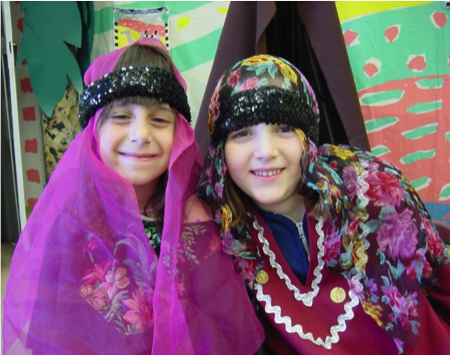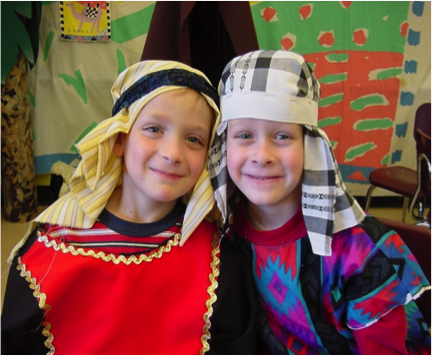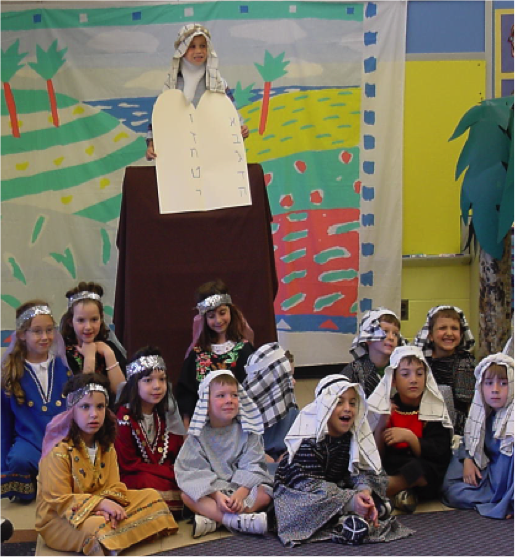Bibliodrama of Giving of the Torah to the Jewish People
(Inspired by “Torah Alive!”)
Suggested Costumes


You may collect adult sized new or used T-shirts, old nightgowns, and pajamas. They are perfect for the long robes worn by men and women of biblical times. Long robes and vests can be easily fashioned from large pieces of all different kinds of fabric or old pillowcases. You may also fashion a “no sew” pinnie. (Directions below)
Seder Costumes-Directions Video (Good for any story from the Torah!)
1. Cut a piece of fabric approximately 12” x 48”. (Based on size of children)
2. Bring short sides together, folding in half.
3. Cut small semi circle for head opening on folded edge.
4. Cut a slit on folded side, 1” from each edge.
5. Continue to cut or tear down fabric for approximately 10”.
6. Knot the ties to close the sides and form a robe.
Synopsis
 Three months after they leave Mitzrayim, B’nei Yisrael enters the wilderness of Sinai. They set up camp at the bottom of the mountain. Moshe climbs up the mountain to God, and God calls to him from the mountain. God tells Moshe to tell B’nei Yisrael, “You have seen what I did to the Egyptians and how I brought you to Me. Now, if you will listen carefully to Me and follow My commandments, you will be My treasured people.” Moshe speaks these words to B’nei Yisrael and they answer, “All that God has said, we will do”. Moshe brings B’nei Yisrael’s words back to God. God tells Moshe, “I will come to you in a thick cloud so all the people will hear when I speak with you, and then they will trust you forever.” Moshe brings the people to the bottom of the mountain to meet God. The mountain shakes and smoke surrounds the top. God asks Moshe to come up the mountain. God speaks the words of the Commandments and Moshe tells them to B’nei Yisrael. B’nei Yisrael learns to live by these rules as they continue their journey to the Promised Land
Three months after they leave Mitzrayim, B’nei Yisrael enters the wilderness of Sinai. They set up camp at the bottom of the mountain. Moshe climbs up the mountain to God, and God calls to him from the mountain. God tells Moshe to tell B’nei Yisrael, “You have seen what I did to the Egyptians and how I brought you to Me. Now, if you will listen carefully to Me and follow My commandments, you will be My treasured people.” Moshe speaks these words to B’nei Yisrael and they answer, “All that God has said, we will do”. Moshe brings B’nei Yisrael’s words back to God. God tells Moshe, “I will come to you in a thick cloud so all the people will hear when I speak with you, and then they will trust you forever.” Moshe brings the people to the bottom of the mountain to meet God. The mountain shakes and smoke surrounds the top. God asks Moshe to come up the mountain. God speaks the words of the Commandments and Moshe tells them to B’nei Yisrael. B’nei Yisrael learns to live by these rules as they continue their journey to the Promised Land
Cast
- Moshe
- All students dressed in desert garb
Suggested Scene and Narration
For purposes of dramatizing the lesson, the teacher will be the Narrator or facilitator of the story. After reviewing the appropriate materials and gathering the necessary costumes, scenery, props, etc, the teacher will help the children dress as specific personalities and bring the individuals into the scene as the story unfolds. As the story is told by the teacher, the children will follow the action in mime and movement. The teacher may elicit dialogue through prompting, questioning, and directing. Generally, however, the teacher will need to recite all speaking parts, touching or looking at the person who would be doing the speaking. You may use the suggested dialogue/narration or create your own, trying to remain true to the text.
The scene begins with all of the children,
B’nei Yisrael, assembled around the base of the mountain.
Narrator: Three months have passed since
B’nei Yisrael have left
Mitzrayim. They
have entered the wilderness of Sinai. They set up camp at the bottom of the
mountain.
God: Moshe, I would like you to climb this mountain and come talk with me.”
Moshe: I will do as you ask. (Moshe climbs the mountain/ladder.)
Narrator: Moshe climbs up the mountain to God, and God calls to him from the
mountain.
God: Moshe, tell
B’nei Yisrael My words, the words of God. These are My words. “You have seen the miracles that I have performed. Now, if you will listen
carefully to Me and follow my commandments, you will be My treasured
people.”
Moshe: I spoke with God and you have heard God’s words. What shall I tell God?
Narrator:
B’nei Yisrael answered, saying, “All that God has said, we will do”.
Moshe: God,
B’nei Yisrael has said, “All that God has said, we will do”.
God: Moshe, “I will come to you in a thick cloud so all the people will hear when I
speak with you, and then they will trust you forever.
Moshe:
B’nei Yisrael, you need to come to the bottom of the mountain to meet God.
Narrator: The mountain shakes and smoke surrounds the top.” (Shake the “mountain”
and wave a gray/black fabric or streamers over the top.)
God: Moshe, come up the mountain so I may speak to you and then you will give
My words to
B’nei Yisrael.
Narrator: Moshe climbs up the mountain and receives the 10 Commandments:
Moshe: These are the words that God says:
"1. I am the Lord your God who brought you out of the land of Egypt, out of slavery.
2. You will not pray to any other god but Me. You will not make idols. You will not bow down to idols.
3. Do not ask God to do something bad to someone else.
4. Remember Shabbat and keep it holy. You may work for six days and do all your work, but on the seventh day you must rest.
5. Honor (listen to) you father and your mother.
6. Do not murder (kill).
7. Do not commit adultery. (When you are married, you can’t have another boyfriend or girlfriend.)
8. Do not steal.
9. Do not lie
10. Do not be jealous of something your neighbor or friend has."
Narrator:
Bnei Yisrael learns to live by these rules as they continue their journey to
the Promised Land.
You may want to play the song, “The Promise”, The World of Your Dreams, by Debbie Friedman.
“This is the promise that I have made to you
And you will go forth into freedom
You will be my people and I will be your God
This is the promise I will keep with you.”
(Deborah Lynn Friedman 1991)
Discussion Questions
• What’s another word for Commandments? *(Rules)
• If we didn’t have rules, what would happen?
• Which of the Commandments talk about a person’s relationship (connection) with God?
• Which of the Commandments talk about how a person treats members of his or her family?
• Which of the Commandments talk about how people treat other people?
• If you could add an eleventh commandment, what would it be?